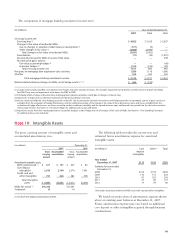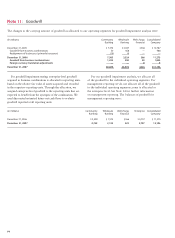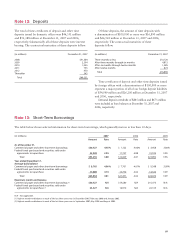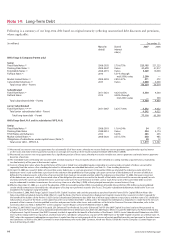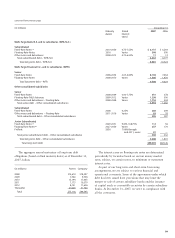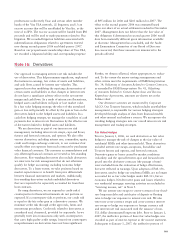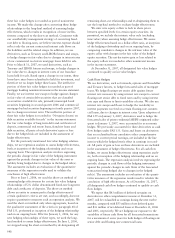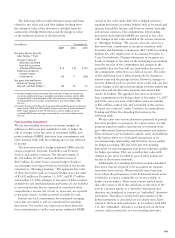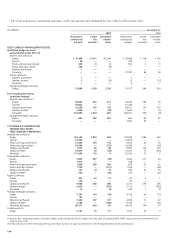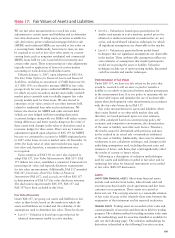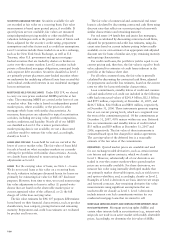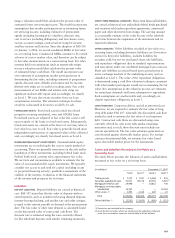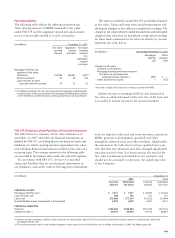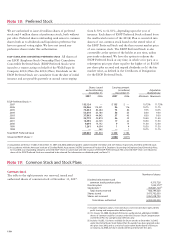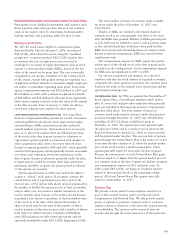Wells Fargo 2007 Annual Report Download - page 108
Download and view the complete annual report
Please find page 108 of the 2007 Wells Fargo annual report below. You can navigate through the pages in the report by either clicking on the pages listed below, or by using the keyword search tool below to find specific information within the annual report.
105
Note 17: Fair Values of Assets and Liabilities
We use fair value measurements to record fair value
adjustments to certain assets and liabilities and to determine
fair value disclosures. Trading assets, securities available for
sale, derivatives, prime residential mortgages held for sale
(MHFS) and residential MSRs are recorded at fair value on
a recurring basis. Additionally, from time to time, we may
be required to record at fair value other assets on a nonre-
curring basis, such as nonprime residential and commercial
MHFS, loans held for sale, loans held for investment and
certain other assets. These nonrecurring fair value adjustments
typically involve application of lower-of-cost-or-market
accounting or write-downs of individual assets.
Effective January 1, 2007, upon adoption of FAS 159,
The Fair Value Option for Financial Assets and Financial
Liabilities, including an amendment of FASB Statement No.
115 (FAS 159), we elected to measure MHFS at fair value
prospectively for new prime residential MHFS originations
for which an active secondary market and readily available
market prices currently exist to reliably support fair value
pricing models used for these loans. We also elected to
remeasure at fair value certain of our other interests held
related to residential loan sales and securitizations. We
believe the election for MHFS and other interests held
(which are now hedged with free-standing derivatives
(economic hedges) along with our MSRs) will reduce certain
timing differences and better match changes in the value of
these assets with changes in the value of derivatives used as
economic hedges for these assets. There was no transition
adjustment required upon adoption of FAS 159 for MHFS
because we continued to account for MHFS originated prior
to 2007 at the lower of cost or market value. At December 31,
2006, the book value of other interests held was equal to
fair value and, therefore, a transition adjustment was
not required.
Upon adoption of FAS 159, we were also required to
adopt FAS 157, Fair Value Measurements (FAS 157). FAS
157 defines fair value, establishes a consistent framework for
measuring fair value and expands disclosure requirements
for fair value measurements. Additionally, FAS 157 amended
FAS 107, Disclosure about Fair Value of Financial
Instruments (FAS 107), and, as such, we follow FAS 157
in determination of FAS 107 fair value disclosure amounts.
The disclosures required under FAS 159, FAS 157 and
FAS 107 have been included in this Note.
Fair Value Hierarchy
Under FAS 157, we group our assets and liabilities at fair
value in three levels, based on the markets in which the
assets and liabilities are traded and the reliability of the
assumptions used to determine fair value. These levels are:
• Level 1 – Valuation is based upon quoted prices for
identical instruments traded in active markets.
• Level 2 – Valuation is based upon quoted prices for
similar instruments in active markets, quoted prices for
identical or similar instruments in markets that are not
active, and model-based valuation techniques for which
all significant assumptions are observable in the market.
• Level 3 – Valuation is generated from model-based
techniques that use significant assumptions not observable
in the market. These unobservable assumptions reflect our
own estimates of assumptions that market participants
would use in pricing the asset or liability. Valuation
techniques include use of option pricing models, discounted
cash flow models and similar techniques.
Determination of Fair Value
Under FAS 157, we base our fair values on the price that
would be received to sell an asset or paid to transfer a
liability in an orderly transaction between market participants
at the measurement date. It is our policy to maximize the use
of observable inputs and minimize the use of unobservable
inputs when developing fair value measurements, in accordance
with the fair value hierarchy in FAS 157.
Fair value measurements for assets and liabilities where
there exists limited or no observable market data and,
therefore, are based primarily upon our own estimates,
are often calculated based on current pricing policy, the
economic and competitive environment, the characteristics
of the asset or liability and other such factors. Therefore,
the results cannot be determined with precision and may
not be realized in an actual sale or immediate settlement
of the asset or liability. Additionally, there may be inherent
weaknesses in any calculation technique, and changes in the
underlying assumptions used, including discount rates and
estimates of future cash flows, that could significantly affect
the results of current or future values.
Following is a description of valuation methodologies
used for assets and liabilities recorded at fair value and for
estimating fair value for financial instruments not recorded
at fair value (FAS 107 disclosures).
Assets
SHORT-TERM FINANCIAL ASSETS Short-term financial assets
include cash and due from banks, federal funds sold and
securities purchased under resale agreements and due from
customers on acceptances. These assets are carried at
historical cost. The carrying amount is a reasonable estimate
of fair value because of the relatively short time between the
origination of the instrument and its expected realization.
TRADING ASSETS Trading assets are recorded at fair value and
consist primarily of securities and derivatives held for trading
purposes. The valuation method for trading securities is the same
as the methodology used for securities classified as available for
sale (see the following page). The valuation methodology for
derivatives is described in the following Derivatives section.


